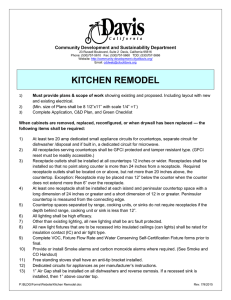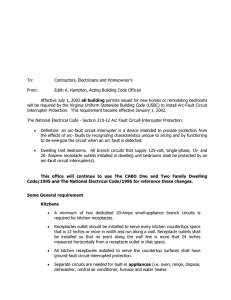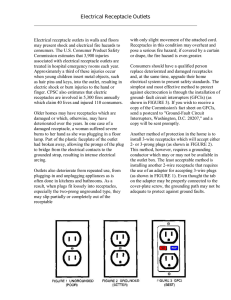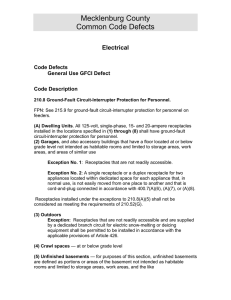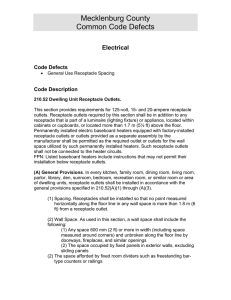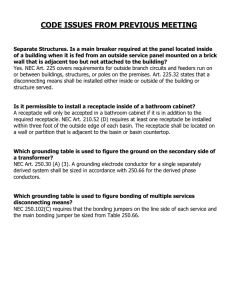Residential Electrical Code Requirements
advertisement
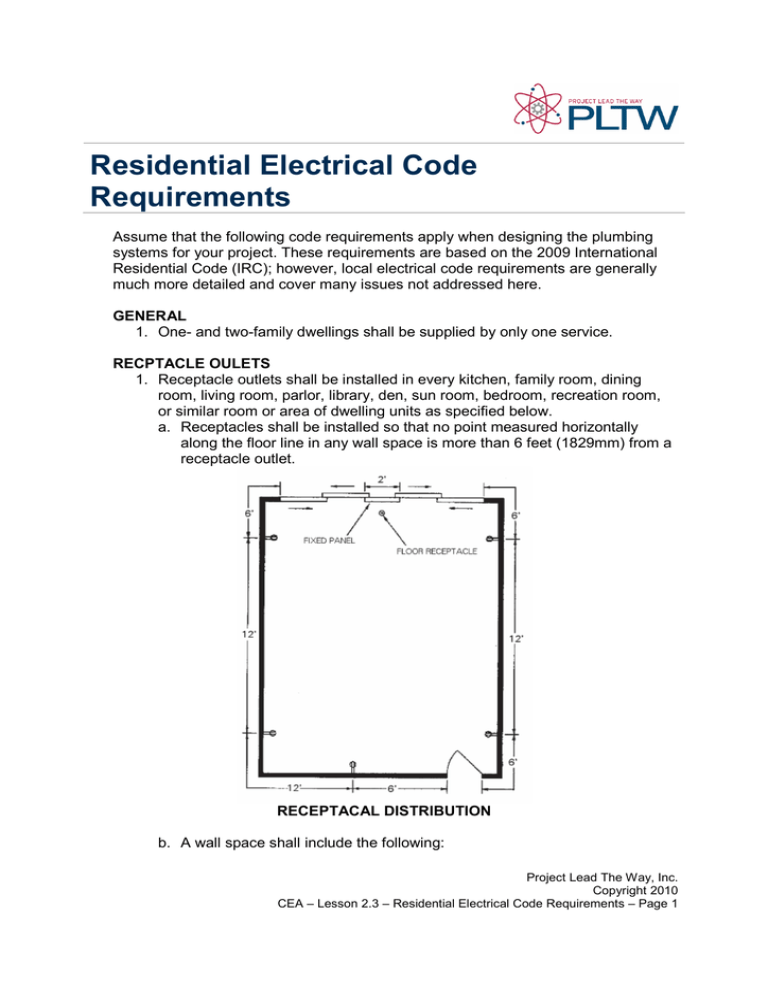
Residential Electrical Code Requirements Assume that the following code requirements apply when designing the plumbing systems for your project. These requirements are based on the 2009 International Residential Code (IRC); however, local electrical code requirements are generally much more detailed and cover many issues not addressed here. GENERAL 1. One- and two-family dwellings shall be supplied by only one service. RECPTACLE OULETS 1. Receptacle outlets shall be installed in every kitchen, family room, dining room, living room, parlor, library, den, sun room, bedroom, recreation room, or similar room or area of dwelling units as specified below. a. Receptacles shall be installed so that no point measured horizontally along the floor line in any wall space is more than 6 feet (1829mm) from a receptacle outlet. RECEPTACAL DISTRIBUTION b. A wall space shall include the following: Project Lead The Way, Inc. Copyright 2010 CEA – Lesson 2.3 – Residential Electrical Code Requirements – Page 1 i. Any space that is 2 feet or more in width, including space measured around corners, and that is unbroken along the floor line by doorways, fireplaces, and similar openings. ii. The space occupied by fixed panels in exterior walls, excluding sliding panels. iii. The space created by fixed room dividers such as railings and freestanding bar-type counters. c. Receptacle outlets in floors shall not be counted as part of the required number of receptacle outlets unless they are located within 18 inches of the wall. 2. In kitchens, pantries, breakfast rooms, dining rooms and similar areas of dwelling units a receptacle outlet shall be installed at each wall countertop space 12 inches or wider. Receptacle outlets shall be installed so that no point along the wall line is more than 24 inches, measured horizontally from a receptacle outlet in that space. a. Exception: Receptacle outlets shall not be required on a wall directly behind a range, counter-mounted cooking unit or sink. 3. At least one receptacle outlet shall be installed at each island countertop space with a long dimension of 24 inches or greater and a short dimension of 12 inches or greater. COUNTERTOP RECEPTACLES Project Lead The Way, Inc. Copyright 2010 CEA – Lesson 2.3 – Residential Electrical Code Requirements – Page 2 4. At least one receptacle outlet shall be installed at each peninsular countertop space with a long dimension of 24 inches or greater and a short dimension of 12 inches or greater. A peninsular countertop is measured from the connecting edge. 5. Countertop spaces separated by range tops, refrigerators, or sinks shall be considered as separate countertop spaces. 6. Receptacle outlets shall be located not more than 20 inches above the countertop. Receptacle outlets shall not be installed in a face-up position in the work surfaces or countertops. a. Exception: Receptacle outlets shall be permitted to be mounted not more than 12 inches below the countertop in construction designed for the physically impaired and for island and peninsular countertops where the countertop is flat across its entire surface and there are no means to mount a receptacle within 20 inches above the countertop, such as in an overhead cabinet. Receptacles mounted below the countertop in accordance with this exception shall not be located where the countertop extends more than 6 inches beyond its support base. 7. At least one wall receptacle outlet shall be installed in bathrooms and located within 36 inches of the outside edge of each lavatory. The receptacle outlet shall be located on a wall or partition that is adjacent to the lavatory basin location, or installed on the side or face of the basin cabinet not more than 12 inches below the countertop. Receptacle outlets shall not be installed in a face-up position in the work surfaces or countertops in a bathroom basin location. 8. At least one receptacle outlet that is accessible while standing at grade level and located not more than 6 feet, 6 inches above grade, shall be installed outdoors at the front and back of each dwelling unit having direct access to grade. Balconies, decks, and porches that are accessible from inside of the dwelling unit and that have a usable area of 20 square feet or greater shall have at least one receptacle outlet installed within the perimeter of the balcony, deck, or porch. The receptacle shall be located not more than 6 feet, 6 inches above the balcony, deck, or porch surface. 9. Hallways of 10 feet or more in length shall have at least one receptacle outlet. The hall length shall be considered the length measured along the centerline of the hall without passing through a doorway. GROUND-FAULT AND ARC-FAULT CIRCUIT-INTERRUPTER PROTECTION 1. All receptacles installed in bathrooms shall have ground-fault circuitinterrupter protection for personnel. 2. All receptacles installed in garages and grade-level portions of unfinished accessory buildings used for storage or work areas shall have ground fault circuit-interrupter protection for personnel. 3. All receptacles installed outdoors shall have ground-fault circuit-interrupter protection for personnel. 4. All receptacles that serve kitchen countertop surfaces shall have ground-fault circuit-interrupter protection for personnel. Project Lead The Way, Inc. Copyright 2010 CEA – Lesson 2.3 – Residential Electrical Code Requirements – Page 3 5. All receptacles that are located within 6 feet of the outside edge of a laundry, utility or wet bar sink shall have ground-fault circuit-interrupter protection for personnel. Receptacle outlets shall not be installed in a face-up position in the work surfaces or countertops. LIGHTING OUTLETS 1. At least one wall switch-controlled lighting outlet shall be installed in every habitable room and bathroom. a. Exceptions: i. In other than kitchens and bathrooms, one or more receptacles controlled by a wall switch shall be considered equivalent to the required lighting outlet. ii. Lighting outlets shall be permitted to be controlled by occupancy sensors that are in addition to wall switches, or that are located at a customary wall switch location and equipped with a manual override that will allow the sensor to function as a wall switch. 2. At least one wall-switch-controlled lighting outlet shall be installed in hallways, stairways, attached garages, and detached garages with electric power. 3. At least one wall-switch-controlled lighting outlet shall be installed to provide illumination on the exterior side of each outdoor egress door having grade level access, including outdoor egress doors for attached garages and detached garages with electric power. A vehicle door in a garage shall not be considered as an outdoor egress door. 4. Where one or more lighting outlets are installed for interior stairways, there shall be a wall switch at each floor level and landing level that includes an entryway to control the lighting outlets where the stairway between floor levels has six or more risers. Project Lead The Way, Inc. Copyright 2010 CEA – Lesson 2.3 – Residential Electrical Code Requirements – Page 4
